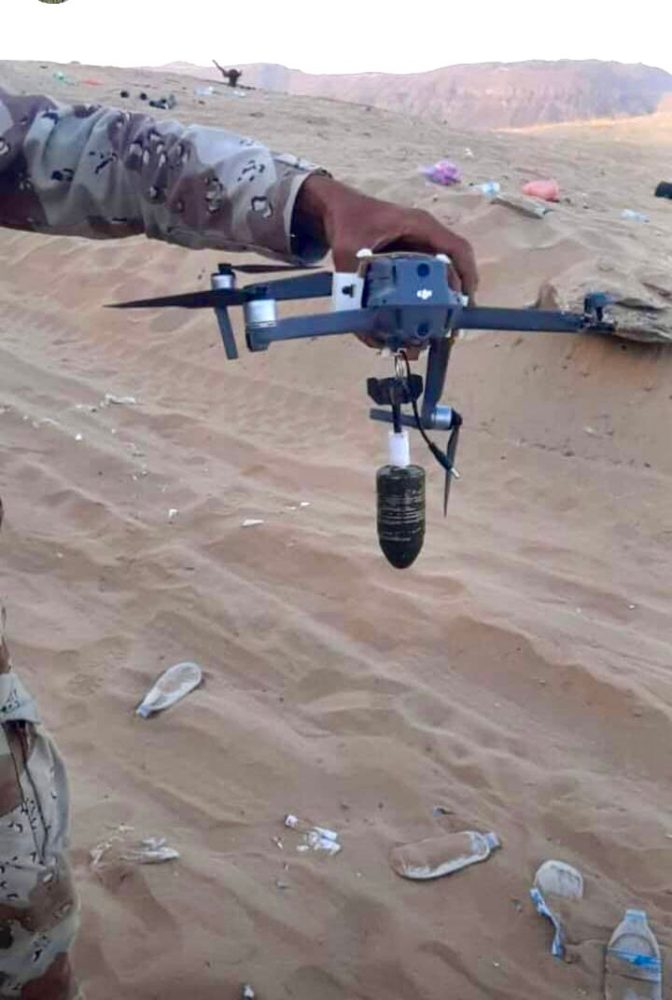
It’s been said that in business there’s no such thing as bad publicity, but a Twitter post showing what appears to be a DJI drone weaponized to drop a grenade on its targets has to be an unwelcome exception.
The weekend tweet was uploaded by Jasper Ellens, an established drone world master of obtaining – and sharing – information whose owners would have preferred to keep under wraps. In this case his post features a photo of a camouflage uniformed arm in a desert setting holding what pretty clearly looks to be a DJI Mavic 2 Pro. Photographed with its back end forward, the partially damaged UAV is outfitted with a carry-and-release mechanism still clutching its unexploded grenade payload.
“At least it didn’t go off when shot down,” Ellens notes. “Don’t try this at home kids.”
In a reply to that tweet, another respected drone and technology figure, Igor Bogdanov writes, “Jasper, this is what it looks like live.” That is accompanied by video from a drone dropping explosive charges on combatants in Ukraine’s civil war as they scatter to escape the plummeting bombs. A bit later Bogdanov adds in Russian, in reference to the original photo, “Favorite toy of the Houthis” – the purportedly Iran-backed Shiite militia locked in a deadly war with a Saudi-led coalition for control of Yemen.
Houthis have been known to use weaponized consumer drones in their confrontation with their wealthier and heavily armed foes. But so, too, have extremists Iraq – who this month staged an explosives-rigged UAV assassination attempt on the nation’s prime minister – not to mention armed groups in Afghanistan and Ukraine. In fact, increased deployment of easily accessible and affordable leisure UAVs for deadly use has been on the rise among militant groups long enough that, way back in 2017, DJI reportedly updated the Go Fly app to prevent its craft from flying over parts of Syria and Iraq under jihadi control. Even Mexican cartels have been reworking drones for attacks on police and rival gangs.
So why would the new photo in this weekend’s tweet represent any trouble for DJI?
It wouldn’t, or shouldn’t in direct or concrete terms. DJI cannot control who purchases, or how buyers use their goods any more than a carmaker can when an unknown driver decides to use an auto to intentionally mow pedestrians down – another rising occurrence, sadly. The distance between producer, end user, and nefarious purpose is too far for any credible association to be made, or any link of manufacturer responsibility to exist. That’s a point DJI made in response to questions about this weekend’s tweeted photo.
“DJI builds our products entirely for peaceful purposes, and we absolutely deplore any use of our products to cause harm anywhere in the world,” says company spokesman Adam Lisberg. “We have no knowledge of what this image displays or where or when it was created. As with the manufacturers of cars, computers and mobile phones, DJI is unable to control how our products are used, but the overwhelming majority of drone users around the world fly safely and responsibly.”
Meanwhile, given its status as the leading producer and seller of excellent, cutting-edge drones, there’s some logic to DJI’s craft also being proportionally represented within the fleets of illicitly weaponized aerial vehicles. The bad guys simply follow the same capacity, effectiveness, and value logic in doing their deadly work as inoffensive operators do.
Yet the enormous gap between manufacturer and obscure, violent-bent user doesn’t prevent what’s popularly referred to as “bad optics” from becoming a potential problem when people see photos like this weekend’s tweet. The shot of a drone dangling what was intended to be a deadly payload – the company logo visible on the rear of the craft – creates the risk of conflation; of that one image becoming a default reference for publics when they read or hear about the increasing weaponization of consumer UAVs in disparate places and conflicts.
That isn’t an accurate, justified, or fair reaction. Yet the mere possibility of one of their craft becoming the poster child of militarized leisure drones in popular thought must inspire the dread of all major manufacturers whenever details, photos, or video hit the news or social networks. This is one spreading phenomenon with which no company wants to be associated.
The potential for reputational damage in that manner is arguably even more complex for DJI, meanwhile, as it weathers recurrent broadsides from US politicians and competitors claiming its drones pose data security risks to government, business, and private users. The company withstood more than a year of those attacks in relatively solid shape, then managed to drown them out with its much anticipated and apparently successful rollout of the new Mavic 3 Pro this month.
The last thing it needs right now is for the ensuing buzz to be killed by photos of an earlier version of that model making the rounds, and feasibly generating dark associations it hasn’t earned with dark forces beyond anybody’s control.
FTC: We use income earning auto affiliate links. More.



Comments